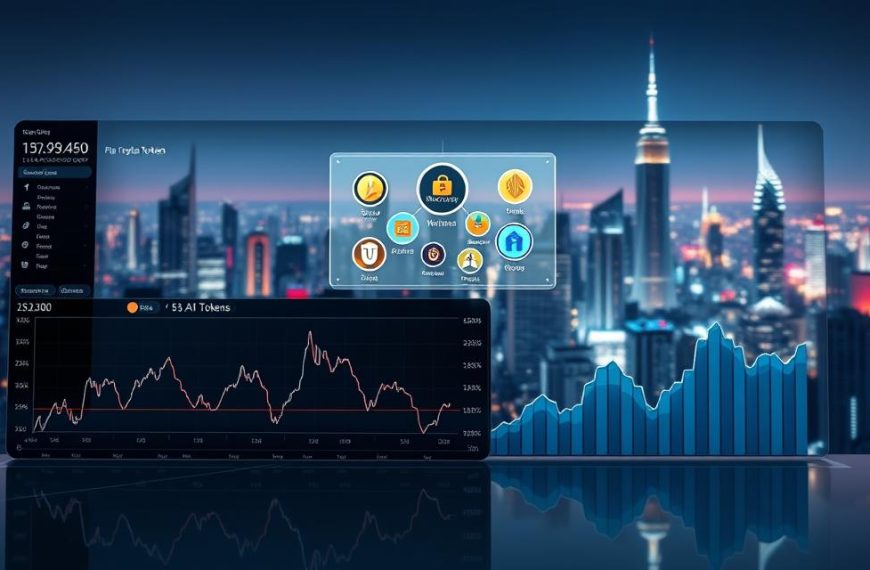The digital asset landscape undergoes profound changes as automated systems redefine strategies for analysing and executing transactions. Recent developments show markets adapting to tools capable of processing vast datasets while identifying patterns invisible to manual analysis. Between October and December 2024, sector capitalisation surged by 223%, reaching £12.3 billion – a shift driven by platforms offering institutional-grade automation to everyday investors.
Modern solutions now combine machine learning with real-time data interpretation, enabling decisions at speeds measured in milliseconds. Unlike basic algorithms, these systems evolve through feedback loops, refining strategies as market conditions fluctuate. Their ability to monitor global exchanges 24/7 addresses a critical challenge in volatile environments where opportunities emerge unpredictably.
OpenAI’s 2025 launch of ChatGPT Agent exemplifies this progress, merging conversational interfaces with professional analytical capabilities. Users deploy complex strategies through natural language prompts, eliminating technical barriers that once limited access. Such innovations democratise participation while raising standards for efficiency across financial ecosystems.
As adoption accelerates, both institutional and retail traders report improved portfolio performance. The focus shifts towards adaptive systems that balance risk management with opportunistic execution – a trend likely to dominate sector discussions throughout 2025.
Introduction: Setting the Stage for AI in the Crypto Market
Modern financial ecosystems are witnessing transformative shifts as automated systems reshape decision-making frameworks. Volatile markets demand solutions that balance speed with precision, particularly in environments where prices fluctuate unpredictably across time zones. Advanced tools now process terabytes of information daily, uncovering trends human analysts might overlook.
Understanding Automated Asset Management Systems
Sophisticated platforms combine machine learning with real-time analytics to interpret market signals. These systems track social sentiment, whale transactions, and macroeconomic indicators simultaneously. For instance, OpenAI’s ChatGPT Agent demonstrates how natural language interfaces simplify strategy deployment, enabling users to execute tasks through conversational prompts.
Recent innovations allow non-technical traders to harness institutional-grade tools. Subscription models like Pro and Team tiers make these capabilities accessible without coding expertise. Users maintain oversight while systems handle execution – a critical feature for risk-aware participants.
Accelerating Market Participation Through Technology
The 24/7 nature of digital markets favours solutions that operate beyond human stamina limits. Automated workflows analyse news cycles and liquidity patterns across exchanges, identifying opportunities in milliseconds. This efficiency becomes vital when managing portfolios exposed to sudden price swings.
Platforms integrating blockchain metrics with traditional indicators offer comprehensive insights. By merging on-chain data with sentiment analysis, these tools provide a multidimensional view of market dynamics. Such approaches address the unique challenges decentralised ecosystems present to conventional analysis methods.
The Emergence of Intelligent Agents in Cryptocurrency
The integration of self-learning systems into financial protocols marks a pivotal shift in how markets operate. These autonomous tools analyse vast datasets across decentralised networks, identifying opportunities faster than traditional methods. Their ability to execute actions like token swaps or governance votes without human intervention reshapes participation dynamics.
Historical Developments and Market Impact
Early systems relied on basic rules for executing orders, limited to single exchanges. Modern iterations combine predictive models with cross-chain compatibility, processing real-time on-chain and social metrics. This evolution enabled platforms like Ai16z to manage £180 million in decentralised funds through adaptive decision-making.
Three phases define progress:
- Rule-based algorithms (2016-2019)
- Machine learning enhancements (2020-2023)
- Natural language interfaces (2024-present)
Tools such as aixbt demonstrate scalability, influencing over 450,000 users with data-driven insights. Security-focused systems like H4CK monitor network vulnerabilities, reducing exploit risks by 37% in recent audits. Content creation agents further diversify applications, generating market analyses that shape community sentiment.
The collective impact includes:
- 27% rise in daily trading volumes across major exchanges
- Improved liquidity in emerging token pairs
- Faster response to regulatory announcements
By merging blockchain transparency with adaptive learning, these systems establish new benchmarks for efficiency. Their role in stabilising volatile markets continues to expand, particularly during high-frequency events.
How to Get Started with ai agent trading crypto
Navigating automated systems in digital markets begins with configuring tools that align with your strategic goals. Modern platforms simplify setup through intuitive interfaces, allowing both new and experienced participants to deploy advanced solutions efficiently.
Activating Agent Mode and Initial Setup
To begin, users activate specialised modes through straightforward commands. For example, typing /agent in compatible platforms unlocks a workspace featuring browser tabs, spreadsheet utilities, and exchange connectors. This environment supports multi-step operations while maintaining oversight through activity logs.
Key setup steps include:
- Linking exchange APIs with read/write permissions
- Configuring data feeds for real-time market signals
- Setting risk parameters like maximum exposure per trade
Defining Clear Trading Prompts and Workflows
Effective systems thrive on precise instructions. Commands such as “Compare ETH/BTC volatility across six exchanges hourly” yield actionable insights. Structured workflows ensure logical progression from data collection to execution, minimising ambiguous outcomes.
Best practices involve:
- Specifying time frames and technical indicators
- Establishing profit targets and stop-loss thresholds
- Scheduling periodic strategy reviews
Platforms now offer modification capabilities during active sessions, letting users adjust parameters as market dynamics shift. This flexibility proves vital when managing positions during unexpected price movements.
Implementing Natural Language and Real-Time Data Analytics
Modern platforms now bridge human intuition with machine precision through conversational interfaces. These systems interpret casual instructions like “Track Bitcoin’s hourly RSI alongside Ethereum whale movements”
Integrating Sentiment Analysis and On-Chain Data
Sophisticated tools cross-reference social chatter with blockchain metrics to spot emerging trends. When X (Twitter) discussions spike about regulatory changes, systems automatically scan related wallet activity across networks. This fusion reveals connections between public sentiment and tangible market shifts.
| Data Source | Key Metrics | Impact on Decisions | Tools Used |
|---|---|---|---|
| Social Feeds | Sentiment polarity | Predicts short-term volatility | X/Twitter API |
| Blockchain | Whale transactions | Flags accumulation patterns | Etherscan |
| News Outlets | Regulatory updates | Triggers risk adjustments | Google Alerts |
| Technical Charts | SMA crossovers | Identifies entry/exit points | TradingView |
Utilising Natural Language for Precise Commands
Users articulate complex workflows through plain English, such as “Alert me if ETH’s 50-day SMA crosses below 200-day while US SEC news sentiment turns negative”. Platforms decompose these instructions into coordinated actions across data streams.
Advanced systems even suggest optimisations. If a command lacks stop-loss parameters, they might propose: “Shall I apply 5% trailing stop based on historical volatility?” This collaborative approach enhances strategy robustness while maintaining user control.
Leveraging Blockchain and Smart Contract Integration
Decentralised networks now serve as critical infrastructure for executing sophisticated financial strategies. By embedding blockchain protocols directly into operational frameworks, systems gain real-time access to immutable records and programmable agreements. This integration transforms how participants interact with markets, offering both transparency and automation at scale.
Connecting to On-Chain Metrics and Tools
Secure wallet management forms the backbone of trustworthy operations. Platforms utilise enterprise solutions like AWS Key Management Service (KMS) to safeguard digital assets. Private keys remain encrypted, never exposed during transactions – a vital feature for mitigating theft risks.
Blockchain data feeds power decision-making through metrics such as:
- Real-time token movement tracking
- Smart contract interaction frequencies
- Cross-network liquidity patterns
| Functionality | Tools Used | Key Impact | Use Cases |
|---|---|---|---|
| Wallet Security | AWS KMS | Prevents key leakage | Transaction signing |
| Data Retrieval | Amazon Managed Blockchain | Live network insights | Arbitrage detection |
| Contract Execution | Ethereum Virtual Machine | Automates DeFi strategies | Yield farming |
| Cross-Chain Analysis | Bridge Protocols | Identifies fee differentials | Asset transfers |
Remote Procedure Call (RPC) endpoints enable direct communication with blockchain networks. Systems query token prices, gas fees, and confirmation times without third-party dependencies. This immediacy proves crucial when executing time-sensitive trades across multiple exchanges.
Smart contract integration extends capabilities beyond basic transactions. Automated systems participate in governance votes or liquidity provision, reacting to protocol updates within milliseconds. Such functionality reshapes portfolio management, particularly in fast-moving decentralised markets.
Enhancing Security and Managing Risk in AI Trading Workflows
Protecting assets in self-operating systems demands layered defences against evolving threats. Modern platforms combine technical safeguards with user control protocols, ensuring automated processes never override human oversight. This balance proves critical when managing volatile markets where milliseconds matter.
Establishing Guardrails and Control Protocols
Systems like Amazon Bedrock Guardrails create digital barriers against unauthorised actions. They block attempts to alter core instructions or bypass spending limits, while requiring manual approval for high-value transfers. Input validation rules and response filters add extra scrutiny before executing irreversible decisions.
Mitigating Data Vulnerabilities
Secure authentication methods and rate limiting protect API connections from exploitation. Platforms cross-verify information sources to make sure trading signals reflect accurate data. Real-time monitoring tools flag unusual activity, triggering pauses during extreme market swings.
These measures work alongside portfolio diversification rules and volatility assessments. By prioritising security without sacrificing efficiency, systems maintain trust while navigating complex financial landscapes.
















